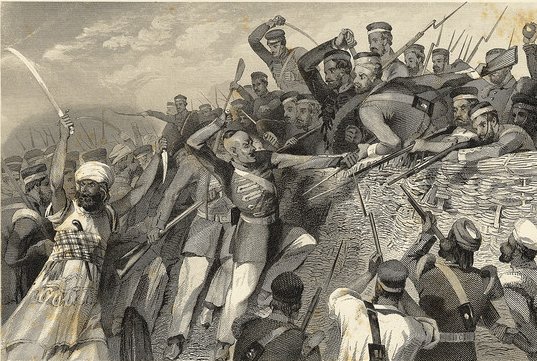 The Sepoy Mutiny in 1857.
The Sepoy Mutiny in 1857.
Most Indian soldiers in the East India Company’s army came from peasant families, so they were deeply affected by their impoverished status. Even in the army, there was a bias shown toward Indians. Not many Indians held a post higher than that of a Subhedar, and their salary was much less than their English counterparts. All this had made them discontented with the English. Against such a background came the rumours that the new Enfield Rifle cartridges issued to the troops were greased with a mixture of cow and pig fat. Since it was army practice to open the cartridges by biting off a twist of paper at one end, both Hindus and Muslims believed they were being asked to violate religious taboos.
This offence lit the fuse of rebellion and finally on the 29th March, 1857, a soldier Mangal Pande rebelled during a military parade and fired at the officer in command. He was arrested and hanged which was the undoing of the mass rebellion. In April, 1857, Indian soldiers of the cavalry unit of Meerut refused to use the new cartridges, and hence were arrested and thrown into prison. Enraged by this latest act of atrocity, the whole battalion charged to Delhi and were joined on the way by thousands of common people.
 The Attack of Mutineers, July 30, 1857
The Attack of Mutineers, July 30, 1857
One of their leaders waving his sword, shouted 'Come on my braves! Illustration from London Printing Company Limited
The mutiny spread like wild fire. Forces were dispatched from Madras and Bombay. However, the revolt had quickly spread to Kanpur and Lucknow. Kanpur, a city controlled by British on the Ganges 250 miles southeast of Delhi,surrendered to the Indian soldiers on June 28, 1857, and was the scene of a massacre before it was recaptured by the British on July 16. Lucknow, forty-five miles to the northeast, had been immediately besieged by the mutineers and was relieved by Henry Havelock's troops on September 25, five days after the final reoccupation of Delhi, the other chief center of the mutiny. However, Havelock's forces, even when joined by those of James Outram, were not strong enough to disarm and remove the enemy garrison, and they had to be relieved on November 16 by troops under Colin Campbell. The civilians of Lucknow were evacuated, but not until the had enough British troops massed to defeat the rebel army.
The final stage of the mutiny took place in central India, which was aroused by a roving band of rebels under the Maratha General Tatya Tope. After his capture and execution in April 1859, the leaderless Indians were soon pacified. Ultimately, the seeming impasse was broken by the arrival of reinforcements from England and the mutiny was crushed after 14 months. A four-month siege broke the rebels’ hold on Delhi. By January 1859, the last of the rebel armies had been hunted down. Everywhere, the British exacted bloody retribution for the massacres that had started the uprising. The mutiny failed due to lack of a leader and proper coordination.
